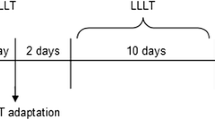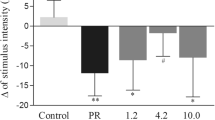Abstract
The syndrome of heart failure (HF) promotes central and peripheral dysfunctions that result in functional capacity decrease, leading to fatigue, dyspnea, and exercise intolerance. The use of light-emitting diode therapy (LEDT) has shown good results reducing fatigue and exercise intolerance, when applied on skeletal muscles before or after exercises. Thereby, the aim of this study was to compare the effects of LEDT on functional capacity, aerobic power, and hemodynamic function in HF rats. Male Wistar rats (230–260 g) were randomly allocated into three experimental groups: Sham (n = 6), Control-HF (n = 4), and LEDT-HF (n = 6). The animals were subjected to an exercise performance test (ET) with gas analysis coupled in a metabolic chamber for rats performed two times (6 and 14 weeks after myocardial infarction). On the day after the baseline aerobic capacity test, the animals were submitted during 8 weeks to the phototherapy protocol, five times/week, 60 s of irradiation, 6 J delivered per muscle group. Statistical analysis was performed by one- and two-way ANOVAs with repeated measures and Student-Newman-Keuls post hoc tests (p ≤ 0.05). Comparing the percentage difference (Δ) between baseline and the final ET, there was no significant difference for the VO2max variable considering all groups. However, Sham and LEDT-HF groups showed higher relative values than the Control-HF group, respectively, for distance covered (27.7 and 32.5 %), time of exercise test (17.7 and 20.5 %), and speed (13.6 and 12.2 %). In conclusion, LEDT was able to increase the functional capacity evaluated by distance covered, time, and speed of exercise in rats with HF.

Similar content being viewed by others
References
Duscha BD, Schulze PC, Robbins JL, Forman DE (2008) Implications of chronic heart failure on peripheral vasculature and skeletal muscle before and after exercise training. Heart Fail Rev 13(1):21–37. doi:10.1007/s10741-007-9056-8
Phillips SA, Vuckovic K, Cahalin LP, Baynard T (2015) Defining the system: contributors to exercise limitations in heart failure. Heart Fail Clinics 11(1):1–16. doi:10.1016/j.hfc.2014.08.009
Arena R, Pinkstaff S, Wheeler E, Peberdy MA, Guazzi M, Myers J (2010) Neuromuscular electrical stimulation and inspiratory muscle training as potential adjunctive rehabilitation options for patients with heart failure. J Cardiopulm Rehabil Prev 30(4):209–223. doi:10.1097/HCR.0b013e3181c56b78
Dobsak P, Novakova M, Siegelova J, Fiser B, Vitovec J, Nagasaka M, Kohzuki M, Yambe T, Nitta S, Eicher JC, Wolf JE, Imachi K (2006) Low-frequency electrical stimulation increases muscle strength and improves blood supply in patients with chronic heart failure. Circ J : Off J Jpn Circ Soc 70(1):75–82. doi:10.1253/circj.70.75
de Leon EB, Bortoluzzi A, Rucatti A, Nunes RB, Saur L, Rodrigues M, Oliveira U, Alves-Wagner AB, Xavier LL, Machado UF, Schaan BD, Dall’Ago P (2011) Neuromuscular electrical stimulation improves GLUT-4 and morphological characteristics of skeletal muscle in rats with heart failure. Acta Physiol (Oxf) 201(2):265–273. doi:10.1111/j.1748-1716.2010.02176.x
Dall’Ago P, Chiappa GR, Guths H, Stein R, Ribeiro JP (2006) Inspiratory muscle training in patients with heart failure and inspiratory muscle weakness: a randomized trial. J Am Coll Cardiol 47(4):757–763. doi:10.1016/j.jacc.2005.09.052
Jaenisch RB, Hentschke VS, Quagliotto E, Cavinato PR, Schmeing LA, Xavier LL, Dal Lago P (2011) Respiratory muscle training improves hemodynamics, autonomic function, baroreceptor sensitivity, and respiratory mechanics in rats with heart failure. J Appl Physiol 111(6):1664–1670. doi:10.1152/japplphysiol.01245.2010
Biasibetti M, Rojas DB, Hentschke VS, Moura DJ, Karsten M, Wannmacher CM, Saffi J, Dal Lago P (2014) The influence of low-level laser therapy on parameters of oxidative stress and DNA damage on muscle and plasma in rats with heart failure. Lasers Med Sci 29(6):1895–1906. doi:10.1007/s10103-014-1597-1
Hentschke VS, Jaenisch RB, Schmeing LA, Cavinato PR, Xavier LL, Dal Lago P (2012) Low-level laser therapy improves the inflammatory profile of rats with heart failure. Lasers Med Sci. doi:10.1007/s10103-012-1190-4
Baroni BM, Leal Junior EC, De Marchi T, Lopes AL, Salvador M, Vaz MA (2010) Low level laser therapy before eccentric exercise reduces muscle damage markers in humans. Eur J Appl Physiol 110(4):789–796. doi:10.1007/s00421-010-1562-z
Ferraresi C, de Brito OT, de Oliveira ZL, de Menezes Reiff RB, Baldissera V, de Andrade Perez SE, Matheucci Junior E, Parizotto NA (2011) Effects of low level laser therapy (808 nm) on physical strength training in humans. Lasers Med Sci 26(3):349–358. doi:10.1007/s10103-010-0855-0
Leal Junior EC, Lopes-Martins RA, Vanin AA, Baroni BM, Grosselli D, De Marchi T, Iversen VV, Bjordal JM (2009) Effect of 830 nm low-level laser therapy in exercise-induced skeletal muscle fatigue in humans. Lasers Med Sci 24(3):425–431. doi:10.1007/s10103-008-0592-9
Leal Junior EC, Lopes-Martins RA, de Almeida P, Ramos L, Iversen VV, Bjordal JM (2010) Effect of low-level laser therapy (GaAs 904 nm) in skeletal muscle fatigue and biochemical markers of muscle damage in rats. Eur J Appl Physiol 108(6):1083–1088. doi:10.1007/s00421-009-1321-1
Vieira WH, Ferraresi C, Perez SE, Baldissera V, Parizotto NA (2012) Effects of low-level laser therapy (808 nm) on isokinetic muscle performance of young women submitted to endurance training: a randomized controlled clinical trial. Lasers Med Sci 27(2):497–504. doi:10.1007/s10103-011-0984-0
de Brito Vieira WH, Bezerra RM, Queiroz RA, Maciel NF, Parizotto NA, Ferraresi C (2014) Use of low-level laser therapy (808 nm) to muscle fatigue resistance: a randomized double-blind crossover trial. Photomed Laser Surg 32(12):678–685. doi:10.1089/pho.2014.3812
Borsa PA, Larkin KA, True JM (2013) Does phototherapy enhance skeletal muscle contractile function and postexercise recovery? A systematic review. J Athl Train 48(1):57–67. doi:10.4085/1062-6050-48.1.12
Miranda EF, Leal-Junior EC, Marchetti PH, Dal Corso S (2014) Acute effects of light emitting diodes therapy (LEDT) in muscle function during isometric exercise in patients with chronic obstructive pulmonary disease: preliminary results of a randomized controlled trial. Lasers Med Sci 29(1):359–365. doi:10.1007/s10103-013-1359-5
Ferraresi C, Hamblin MR, Parizotto NA (2012) Low-level laser (light) therapy (LLLT) on muscle tissue: performance, fatigue and repair benefited by the power of light. Photon Lasers Med 1(4):267–286. doi:10.1515/plm-2012-0032
Leal-Junior EC, Vanin AA, Miranda EF, de Carvalho PD, Dal Corso S, Bjordal JM (2013) Effect of phototherapy (low-level laser therapy and light-emitting diode therapy) on exercise performance and markers of exercise recovery: a systematic review with meta-analysis. Lasers Med Sci. doi:10.1007/s10103-013-1465-4
Ferraresi C, Parizotto NA, Pires de Sousa MV, Kaippert B, Huang YY, Koiso T, Bagnato VS, Hamblin MR (2014) Light-emitting diode therapy in exercise-trained mice increases muscle performance, cytochro3/10/2016me c oxidase activity, ATP and cell proliferation. J Biophotonics 1 (15). doi:10.1002/jbio.201400087
Colman D, Melo MC, Brioschi ML, Silveira F, Cimbalista Junior M (2002) Analysis of heat loss using inhalation agents in rats subjected to laparotomy and increased intra-abdominal pressure, using digital infrared thermal image. Rev Bras Anestesiol 52(3):307–315
Hecker BR, Lake CL, DiFazio CA, Moscicki JC, Engle JS (1983) The decrease of the minimum alveolar anesthetic concentration produced by sufentanil in rats. Anesth Analg 62(11):987–990
Campos JC, Queliconi BB, Dourado PM, Cunha TF, Zambelli VO, Bechara LR, Kowaltowski AJ, Brum PC, Mochly-Rosen D, Ferreira JC (2012) Exercise training restores cardiac protein quality control in heart failure. PLoS One 7(12), e52764. doi:10.1371/journal.pone.0052764
Jannig PR, Moreira JB, Bechara LR, Bozi LH, Bacurau AV, Monteiro AW, Dourado PM, Wisloff U, Brum PC (2014) Autophagy signaling in skeletal muscle of infarcted rats. PLoS One 9(1), e85820. doi:10.1371/journal.pone.0085820
Batista ML Jr, Santos RV, Oliveira EM, Seelaender MC, Costa Rosa LF (2007) Endurance training restores peritoneal macrophage function in post-MI congestive heart failure rats. J Appl Physiol 102(5):2033–2039. doi:10.1152/japplphysiol.00871.2006
Camargo MZ, Siqueira CP, Preti MC, Nakamura FY, de Lima FM, Dias IF, Toginho Filho Dde O, Ramos Sde P (2012) Effects of light emitting diode (LED) therapy and cold water immersion therapy on exercise-induced muscle damage in rats. Lasers Med Sci 27(5):1051–1058. doi:10.1007/s10103-011-1039-2
Nunes RB, Tonetto M, Machado N, Chazan M, Heck TG, Veiga AB, Dall’Ago P (2008) Physical exercise improves plasmatic levels of IL-10, left ventricular end-diastolic pressure, and muscle lipid peroxidation in chronic heart failure rats. J Appl Physiol 104(6):1641–1647. doi:10.1152/japplphysiol.00062.2008
Lindpaintner K, Lu W, Neidermajer N, Schieffer B, Just H, Ganten D, Drexler H (1993) Selective activation of cardiac angiotensinogen gene expression in post-infarction ventricular remodeling in the rat. J Mol Cell Cardiol 25(2):133–143
Alves JP, Nunes RB, Stefani GP, Dal Lago P (2014) Resistance training improves hemodynamic function, collagen deposition and inflammatory profiles: experimental model of heart failure. PLoS One 9(10), e110317. doi:10.1371/journal.pone.0110317
Karu T (1999) Primary and secondary mechanisms of action of visible to near-IR radiation on cells. J Photochem Photobiol B Biol 49(1):1–17. doi:10.1016/S1011-1344(98)00219-X
Karu TI, Pyatibrat LV, Kolyakov SF, Afanasyeva NI (2008) Absorption measurements of cell monolayers relevant to mechanisms of laser phototherapy: reduction or oxidation of cytochrome c oxidase under laser radiation at 632.8 nm. Photomed Laser Surg 26(6):593–599. doi:10.1089/pho.2008.2246
Ferraresi C, Kaippert B, Avci P, Huang YY, de Sousa MV, Bagnato VS, Parizotto NA, Hamblin MR (2015) Low-level laser (light) therapy increases mitochondrial membrane potential and ATP synthesis in C2C12 myotubes with a peak response at 3–6 h. Photochem Photobiol 91(2):411–416. doi:10.1111/php.12397
Leal Junior EC, Lopes-Martins RA, Rossi RP, De Marchi T, Baroni BM, de Godoi V, Marcos RL, Ramos L, Bjordal JM (2009) Effect of cluster multi-diode light emitting diode therapy (LEDT) on exercise-induced skeletal muscle fatigue and skeletal muscle recovery in humans. Lasers Surg Med 41(8):572–577. doi:10.1002/lsm.20810
Leal-Junior EC, de Almeida P, Tomazoni SS, de Carvalho PT, Lopes-Martins RA, Frigo L, Joensen J, Johnson MI, Bjordal JM (2014) Superpulsed low-level laser therapy protects skeletal muscle of mdx mice against damage, inflammation and morphological changes delaying dystrophy progression. PLoS One 9(3), e89453. doi:10.1371/journal.pone.0089453
Leal Junior EC, Lopes-Martins RA, Baroni BM, De Marchi T, Rossi RP, Grosselli D, Generosi RA, de Godoi V, Basso M, Mancalossi JL, Bjordal JM (2009) Comparison between single-diode low-level laser therapy (LLLT) and LED multi-diode (cluster) therapy (LEDT) applications before high-intensity exercise. Photomed Laser Surg 27(4):617–623. doi:10.1089/pho.2008.2350
Ihsan FR (2005) Low-level laser therapy accelerates collateral circulation and enhances microcirculation. Photomed Laser Surg 23(3):289–294. doi:10.1089/pho.2005.23.289
Antonialli FC, De Marchi T, Tomazoni SS, Vanin AA, dos Santos GV, de Paiva PR, Pinto HD, Miranda EF, de Tarso Camillo de Carvalho P, Leal-Junior EC (2014) Phototherapy in skeletal muscle performance and recovery after exercise: effect of combination of super-pulsed laser and light-emitting diodes. Lasers Med Sci 29(6):1967–1976. doi:10.1007/s10103-014-1611-7
Miranda EF, de Oliveira LV, Antonialli FC, Vanin AA, de Carvalho PT, Leal-Junior EC (2015) Phototherapy with combination of super-pulsed laser and light-emitting diodes is beneficial in improvement of muscular performance (strength and muscular endurance), dyspnea, and fatigue sensation in patients with chronic obstructive pulmonary disease. Lasers Med Sci 30(1):437–443. doi:10.1007/s10103-014-1690-5
Santos LA, Marcos RL, Tomazoni SS, Vanin AA, Antonialli FC, Grandinetti Vdos S, Albuquerque-Pontes GM, de Paiva PR, Lopes-Martins RA, de Carvalho PT, Bjordal JM, Leal-Junior EC (2014) Effects of pre-irradiation of low-level laser therapy with different doses and wavelengths in skeletal muscle performance, fatigue, and skeletal muscle damage induced by tetanic contractions in rats. Lasers Med Sci 29(5):1617–1626. doi:10.1007/s10103-014-1560-1
Hayworth CR, Rojas JC, Padilla E, Holmes GM, Sheridan EC, Gonzalez-Lima F (2010) In vivo low-level light therapy increases cytochrome oxidase in skeletal muscle. Photochem Photobiol 86(3):673–680. doi:10.1111/j.1751-1097.2010.00732.x
Perini JL, Hentschke VS, Sonza A, Dal Lago P (2016) Long-term low-level laser therapy promotes an increase in maximal oxygen uptake and exercise performance in a dose-dependent manner in Wistar rats. Lasers Med Sci 31(2):241–248. doi:10.1007/s10103-015-1849-8
Acknowledgments
We would like to acknowledge Edson Quagliotto (Ph.D.), Ramiro Barcos Nunes (Ph.D.), and Jadson Alves (M.Sc.) for their assistance during development of this study.
Author information
Authors and Affiliations
Corresponding author
Ethics declarations
Funding
This research was supported by: Fundação de Amparo à Pesquisa do Rio Grande do Sul (FAPERGS, PRONEM—Programa de Núcleos Emergentes, 2011), Conselho Nacional de Desenvolvimento Científico e Tecnológico (CNPq, Chamada Universal, 2012), and Programa Nacional de Pós-doutorado da Coordenação de Aperfeiçoamento de Pessoal de Nível Superior (CAPES, PNPD Concessão Institucional, 2011).
Conflict of interest
The authors declare that they have no conflict of interest.
Ethical approval
All procedures performed in studies involving animals were in accordance with the ethical standards of the institution or practice at which the studies were conducted.
Rights and permissions
About this article
Cite this article
Capalonga, L., Karsten, M., Hentschke, V.S. et al. Light-emitting diode therapy (LEDT) improves functional capacity in rats with heart failure. Lasers Med Sci 31, 937–944 (2016). https://doi.org/10.1007/s10103-016-1922-y
Received:
Accepted:
Published:
Issue Date:
DOI: https://doi.org/10.1007/s10103-016-1922-y




